How to utilize the consistency number
One of my favorite features of the reports available in TPS is the ‘Consistency’ number located under the ‘Averages’ reading. To be honest, I probably overlooked this number at first, as I wasn’t quite sure what exactly it was telling me.
I now view it as a key piece of the puzzle in evaluating a player’s ability, and it can help the coach know how to approach the improvement process.
So what exactly does the ‘Consistency’ number represent? It reflects the Standard Deviation of the collection of data within each parameter. The Standard Deviation is a measure of how spread out numbers are. The bigger the number, the wider the dispersion of the results.
Below is a graphical representation of two sets of shots from 70 and 80 yards from one of our students who is a competitive junior golfer. His Consistency, or Standard Deviation, from 70 yards was 4.8 yards. And from 80 yards his Standard Deviation was 3.5. He was more Consistent in his Carry distance from 80 yards than 70, hence the smaller circle around the shots at each target.
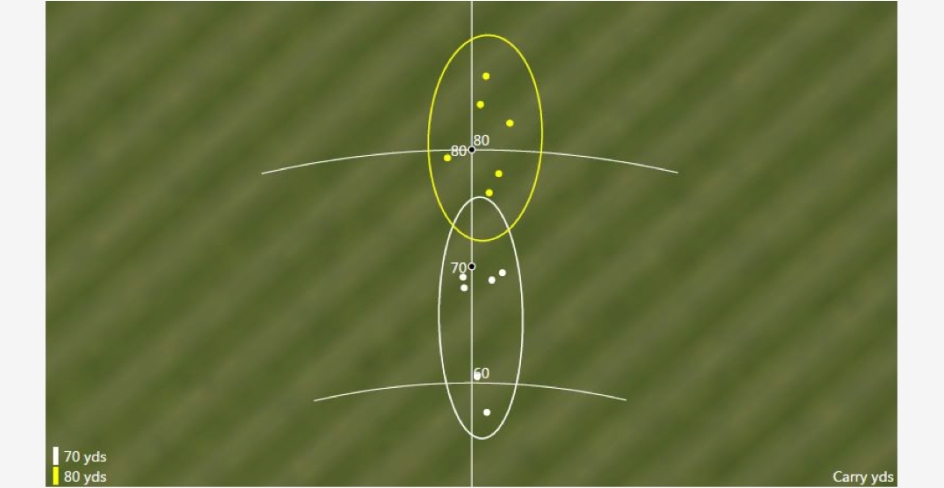

To help illustrate how you can utilize the Consistency reading, let’s take a look at Justin Rose’s TrackMan Combine Report from February of 2012.
Here are the Average and Consistency readings from 60 yards.
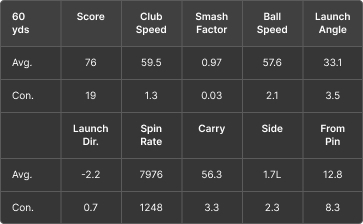

And these are his numbers from 70 yards.
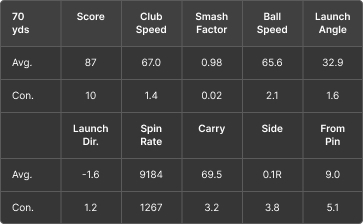

The first thing we should see is that his average score from 70 yards is 87 points, and from 60 yards is only 76. Yes, we could just suggest some practice at those targets to see some improvement. But by comparing both of those results to a target he excelled at, we can start to see some indicators as to just WHAT he may want to focus his practice on.
Here are his numbers from 80 yards.
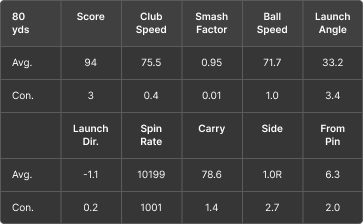

Where do we see some differences?
To my eye, the parameter with the biggest difference that a player can respond to easiest (whether they are a touring professional or amateur) is the Club Head Speed reading.
His Club Head Speed consistency from 60 and 70 yards has three times the amount of standard deviation than from 80 yards. In this case, structuring a practice regimen that is designed around the player gaining a better understanding of controlling their Club Head Speed would be very beneficial. His Smash Factor consistency at all three targets is very consistent, so that is telling to me that the player’s ability to manage impact location, Face to Path and Spin Loft is exceptional.
If there is a second number that I’d be concerned about, it would be his Spin Rate consistency at all three targets. By comparison, Jason Dufner & Justin Rose’s Spin Rate consistency numbers for those three targets are:
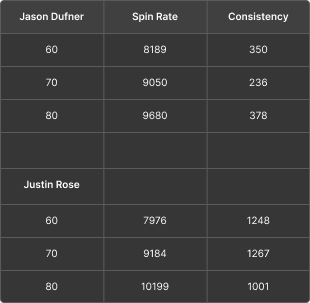

What this indicates is that some other factors may be in play as to why they could be so different between these two world class players.
First and foremost, I’d be curious as to what golf ball the player was using. We all know range balls tend not to be consistent in their flight and launch conditions when they are no longer new.
Secondly, I’d be looking at what club the player is choosing for those shots. If the club selection is creating too much Spin Loft, the friction barrier between the ball and the club could be impacted and the ball will ‘slip’ on the face during impact. This will result in a higher launch angle and lower spin rate.
I’d highly suggest checking out Andrew Rice’s research and articles concerning ‘Spin Loft Mountain’ if you’d like to know more detailed information on how this can happen. In brief, there is a limit on how CONSISTENT your Spin Rate can be when you have a Spin Loft number above 45-50 degrees. Yes, you can create more spin above that Spin Loft amount, but it is very difficult to do it consistently.
The Consistency reading can be a very valuable tool when trying to evaluate not only the player’s ability, but also in evaluating their equipment, their shot selection, their perception of results, or even their perception of a concept. It is a tool that can help both the player and the coach gain a better understanding of not only what they do well, but it can also let them figure out where to start the improvement process more efficiently.
I’d love to hear how others have used this!
Semper Fidelis,
Pete Weber
TrackMan University Master